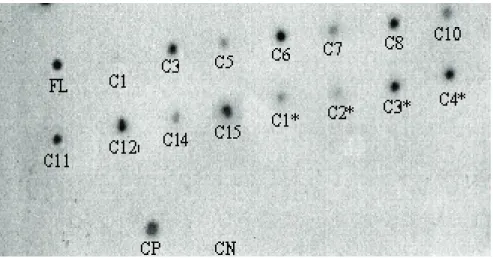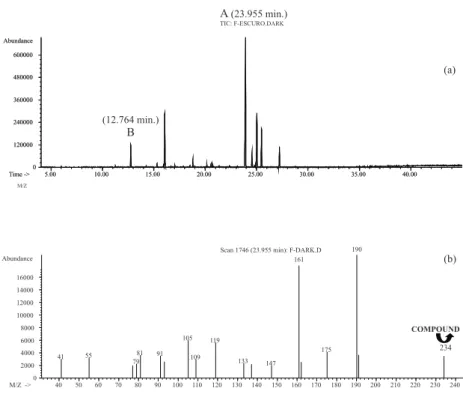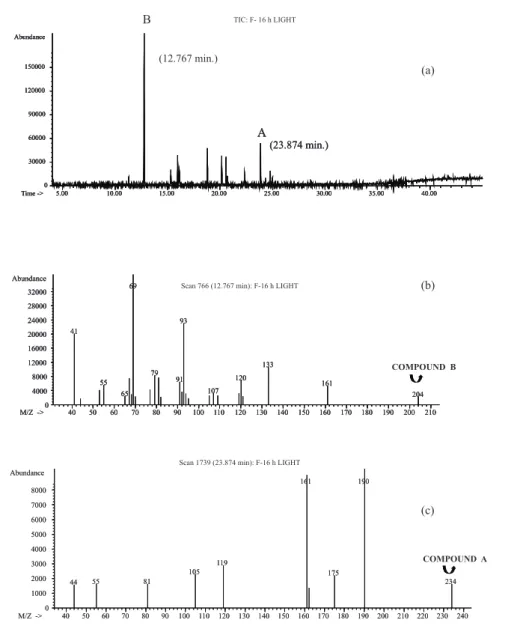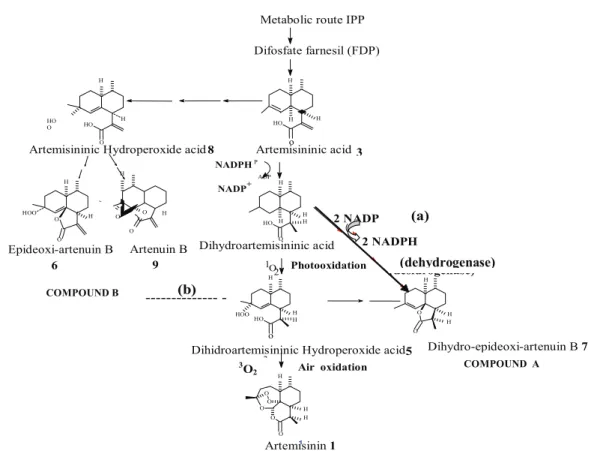Artigo
Received 10/25/05. Accepted 04/19/06 Brazilian Journal of Pharmacognosy
16(3): 291-299, Jul./Set. 2006
Biotechnology approaches for production of antiulcerogenic
dihydro-epideoxyarteannuin B isolated from
Artemisia annua
L.
Daniela A. Marques
1*, Mary A. Foglio
2, Patrícia G. Morgante
3, Marie-Anne Van Sluys
4,
Simone L. Kirszenzaft Shepherd
51,5Universidade Estadual de Campinas, Departamento de Fisiologia Vegetal, Caixa Postal 6109, 13083-970,
Campinas, SP, Brasil,
2Universidade Estadual de Campinas, Centro Pluridisciplinar de Pesquisas Químicas, Biológicas e Agronômicas,
Caixa Postal 6171, 13081-970, Paulínia, SP, Brasil,
3Universidade Estadual Paulista “Júlio de Mesquita Filho”, Faculdade de Agronomia, Unidade Diferenciada de
Registro, Rua Tamekichi Takano 05, 11900-000, Registro, SP, Brasil,
4Universidade de São Paulo, Departamento de Botânica, Rua do Matão 277, Caixa Postal 11461, Cidade
Universitária, 05422-970, São Paulo, SP, Brasil
RESUMO: “Ferramentas biotecnológicas para a produção de dihidro-epideoxiarteanuina B, um antiulcerogênico isolado de Artemisia annua L.”. Foram desenvolvidas metodologias para o estabelecimento e cultivo de raízes de Artemisia annua L. (híbrido CPQBA 2/39 x PL5). Estas raízes foram submetidas a diferentes condições de luz e a transformação genética com Agrobacterium rhizogenes (cepas 8196 e 15834). As raízes transgênicas e não-transgênicas (normais) foram cultivadas em meios de Murashige e Skoog (1962), mantidas sobre diferentes condições de fotoperíodo e analisadas para avaliação do conteúdo do composto antiulcerogênico dehidro-epideoxiarteanuína B (composto A). A confi rmação do caráter transgênico das raízes foi obtida por Dot Blot. Os extratos dos materiais vegetais foram analisados por Cromatografi a Gasosa acoplada a um Espectômetro de Massas (CG/EM). Os cromatogramas dos extratos das raízes normais revelaram a presença de dehidro-epideoxiarteanuína B e de um outro composto (composto B). As condições fotoperiódicas de cultivo infl uenciaram na produção destes dois compostos, sendo que sobre condição de escuro contínuo, dehidro-epideoxiarteanuína B foi intensamente produzido e o composto B foi detectado em pequenas proporções, enquanto que sob fotoperíodo de 16 horas, o inverso ocorreu. A quantifi cação de dehidro-epideoxiarteanuína B por Cromatografi a Gasosa acoplada a um Detector de Ionização de Chamas (CG/FID) revelou um aumento de aproximadamente cinco vezes na produção deste composto pelas raízes normais cultivadas sobre escuro contínuo em relação às raízes cultivadas na presença de 16 horas de luz. O terpeno dehidro-epideoxiarteanuína B não estava presente nas raízes transgênicas.
Unitermos:Artemisia annua,terpeno, cultura de raízes in vitro, raízes transgênicas, luz.
ABSTRACT: Methodologies were developed for the establishment and cultivation of Artemisia annua L (CPQBA 2/39 x PL5 hybrid) roots submitted to light conditions and genetic transformation performed with Agrobacterium rhizogenes (15834 and 8196 strains). The transgenic and non-transgenic (normal) roots were cultured in Murashige and Skoog (1962) medium, kept under different photoperiodic conditions and analyzed for evaluation of the antiulcerogenic dihydro-epideoxyarteannuin B (compound A) contents. The Dot Blot technique was used to confi rm the transgenic nature of the roots. The plants′s crude extracts were analyzed by Gas Chromatography coupled to Mass Spectrum (CG/MS). The chromatograms of the extracts taken from normal roots revealed the presence of dihydro-epideoxyarteannuin B and other compound (compound B). Photoperiods during cultivation infl uenced the production of these two compounds: under continuous darkness dihydro-epideoxyarteannuin B was intensely produced and the compound B present in small amounts, while on 16 h photoperiod, the inverse occurred. The quantifi cation of dihydro-epideoxyarteannuin B by Gas Chromatography coupled to Flame Detector Ionization (CG/ FID) revealed an approximately fi vefold increase in the production of this compound by normal roots kept under continuous darkness compared to roots kept under 16 h light period. The terpene dihydro-epideoxiarteannuin B was not present in transgenic hairy roots.
INTRODUCTION
The specie A. annua is a rich source of sesquiterpenes, isoprenoids, volatile oils, mono and diterpenes with important pharmaceutical properties, including antimalarial, antitumoral, antiviral, anti-infl ammatory, antibiotic and antiulcerogenic activities (Sy; Brown, 2001; Tan et al., 1998; Duarte et al., 2004). Foglio et al. (2002) demonstrated that the artemisinin extraction by-product exhibited intense antiulcerogenic activity in ulcer models induced by indometacin and ethanol comparable to the standard drug carbenoxolone. According to the authors, artemisinin did not provide cytoprotection under the experimental models tested. Only the dihydro-epideoxyarteannuin B and deoxyartemisinin decreased the ulcerative lesion index produced by ethanol and indomethacin in rats. Thus, these compounds have proved to be promising drugs in ulcer control. The gastric ulcer is a disease that attacks large number of population. Actual lifestyle factors such as diet, stress, alcoholic drinks and drug abuse are known to worsen ulcer conditions. Therefore, there is an urgent need for new effi cient drugs for gastric ulcer prophylaxis (Dias, 1997).
Small quantities of dihydro-epideoxyarteannuin B was found in A. annua roots cultured both in vivo and in vitro conditions (Marques, 2002). Tools of biotechnology such as tissue culture and genetic transformation have been a promising possibility to increase the production of antimalarial artemisinin in A. annua (Weathers et al., 2005; Abdin et al. 2003). The advantage of in vitro cultures is the easy manipulation of environmental conditions such as light condition or culture medium specifi city to maximize the metabolic production.
Metabolic route engineering is a very important tool for increasing a target compound, thus the complete elucidation of biosynthetic route of artemisinin (and precursors) is required. Wallaart et al. (1999) proved that dihydroartemisininic acid and dihydroartemisininic acid hydroperoxide are the direct biosynthetic precursors of artemisinin. Several authors confi rmed that the level of artemisinin and others terpenes production is dependent of factors such as O2 (Wallaart et al., 2000) and light conditions (Jaziri et al., 1995; Wang et al., 2001; Liu et al., 2002; Weathers et al., 2005). Light can greatly affect the regulation of some genes involved in terpenoids biosynthesis as CLA1 that encodes 5-phosphate syntetase (DXPS) and 1-Deoxy-D-xylulose-5-phosphate reductoisomerase (DXPR). These enzymes are involved in initial steps in the biosynthesis of isopentenyl diphosphate (IPP) (Souret et al., 2002).
Terpenoids are derived from the precursor IPP. Higher plants have two independent biosynthetic pathways leading to the formation of IPP: mevalonate pathway in the cytoplasm and the mevalonate-independent alternative pathway associated with plastids. This alternative pathway is involved in the biosynthesis
of plastidic terpenoids, mainly monoterpenes, diterpenes and carotenoids whereas sesquiterpenes appear to be synthesized primarily from the cytoplasmatic pools of IPP (Souret et al., 2002).
A careful analysis under different conditions of the regulation of the key biosynthetic genes involved may improve the selection of root growth conditions to maximize production of either plastidial or cytoplasmically produced terpenes. The aim of this work was the establishment and cultivation of A. annua L. roots submitted to different light conditions and genetic transformation performed with two strains of A. rhizogenes
(15834 and 8196) for studying antiulcerogenics dihydro-epideoxyarteannuin B production. This protocol can be used for future scale-up bioreactors production. It is suggested a possible pathway for the biosynthetic route of dihydro-epideoxyarteannuin B and related compounds and its relation with artemisinin biosynthetic route.
MATERIAL AND METHODS
Plant material and tissue culture conditions
Hybrid plants of A. annua L. (CPQBA 2/39 x PL5) were collected in Centro Pluridisciplinar de Pesquisas Químicas, Biológicas e Agrícolas (CPQBA) experimental field localized in Paulínia/SP, Brazil (22o48´Lat.S.47o07´Long, alt. 669m). Dr. Condorcet Aranha of Instituto Agronômico de Campinas (IAC) was responsible for the specie identifi cation. Approval for the collection was granted by the appropriate authority in the country of origin as cultivated species. Exsicate localization: CPQBA 1246. The seeds were germinated aseptically in MS (Murashige; Skoog, 1962) medium as previously described by Marques and Shepherd (2000). The seedlings obtained were monthly transferred to others fl asks containing the same medium.
Establishment of normal root cultures
Normal roots cultures were established by transferring root tips (1-2 cm in length) of sterile A. annua
plantlets onto Erlenmeyer fl asks (250 mL) containing liquid MS medium supplemented with 0.01 mg l-1 of synthetic
auxin indol butyric acid (IBA). These cultures were kept under two photoperiodic conditions: 16 h light/day (16 h photoperiod) and 24 h darkness/day (continuous darkness) (Marques; Shepherd, 2000). Environmental conditions of culture such as temperature (25 ± 2 °C); incandescent white light (3000 mM m-2.s-1); pH value of 5.8 and orbital shaker
velocity (110 rpm) were equal in all experiments of this work.
Establishment of transgenic root cultures
plantlets and inoculated with two strains of A. rhizogenes
(8196 and 15834). In order to obtain transgenic hairy roots, the basal side of each segment was placed on freshly prepared bacteria culture disposed on solid AT (Petit; Tempé, 1978) medium as previously described by Peres et al. (2001). Inoculated segments were plunged, basal end up, into solidifi ed medium composed by distilled water and agar (8.0 gl-1). As result of inoculation, roots emerged in the
basal end up of segments. These roots were individualized and placed in a media containing half strength MS salts. Antibiotic (Claforan-100 mgl-1) was added into the medium
to prevent bacterial growth (Marques; Shepherd, 2000). After the Agrobacterium elimination, the axenic hairy roots were cultivated in hormone free MS medium supplemented with 3% w/v sucrose and 8.0 gl-1 agar. The cultures were
kept under two photoperiodic conditions: 16 h photoperiod or continuous darkness.
Extracts preparation
Roots cultivated in vitro were excised and dried under air circulation (40 °C) then grinded for use. The following dry weight data was obtained: 1.48 g (normal roots cultivated on darkness); 1.05 g (normal roots cultured on 16 h photoperiod); 0.98 g (transgenic hairy roots cultured on darkness) and 1.25 g (transgenic hairy roots cultured on 16 h light).
For extraction, the resulting dry material was dynamically macerated with dichloromethane solution, placed in shaker for 2 h and then, fi ltered. This procedure was repeated three times. The fi ltered material was then stored. The crude dichloromethane extracts result in: 52.20 mg of roots cultured on darkness; 33.91 mg of roots cultured on 16 h light; 34.42 mg of transgenic hairy roots cultured on 16 h light and 30.05 mg of transgenic hairy roots cultured on darkness.
DNA extraction and molecular analysis of hairy roots
The hairy roots DNA extraction was performed according to methodology reported by Fulton et al. (1995). Dot Blot analysis used approximately 500 ng of hairy root extracted DNA and each sample was prepared in 5 μl fi nal volume and deposited onto a nylon membrane following standard procedures (Sambrook; Russel, 2001). Samples of tomato transgenic and non-transgenic roots were used as positive and negative controls respectively, which were kindly provided by Patrícia Gleydes Morgante (Peres et al., 2001). Membrane hybridization was carried out as described by Sambrook; Russel (2001) after 32P-labeling
of probe with the Random Primers DNA Labeling System (Invitrogen™ Life Technologies). In order to search for positive transgenic root clones, a 3.6 kbp ORF13 fragment from T-region of A. rhizogenes plasmid Ri (pRi) was selected to probe the membrane.
Column chromatography
The chromatography of the sesquiterpene-enriched fraction (2.5 g) was made on Silica gel 60 (0.063-0.200 mm) using an increasing polar mixture of hexane/ethyl acetate 35%. Dihydro-epideoxyartenuin B was identifi ed comparing their spectral data with previous studies data (Foglio et al., 2002).
Gas chromatography coupled to spectrum mass (GC/ MS)
Analysis were carried out using a HP-5890/5970 system equipped with a J & W Scientifi c DB-5 fused capillary column (25 m x 0.2 mm x 0.33 m), temperature program 40 °C (5 °C/min) – 300 °C (10 min), with an injector temperature equal to 250 °C and detector temperature equal to 300 °C. Helium was used as the carrier gas (0.7 bar, 1 ml min-1). The Spectrum Mass was taken at 70 eV. Scanning
speed was scans/s from 40 to 550. Sample volume was 1 μl.
Gas chromatography coupled to fl ame ionization detector (CG/FID) – Quantifi cation
The conditions used for GC/MS were maintained. Linear calibration standard curve of this sesquiterpene was obtained in 0.18 mg ml-1, 0.73 mg ml-1 and 1.82 mg ml-1
(Curve equation: y = 31658x – 1167.5 and R2=0.9976, where y = height and x = length).
RESULTS
The normal and the transgenic roots obtained grew vigorously in specifi cs media. Infected microcuttings with 15834 A. rhizogenes strain induced 75% of explants to root and 7.87 ± 1.17 roots/microcuting. The inoculation with 8196 A. rhizogenes strain promoted a smaller rooting percentage (30%) and number of roots/microcutting (3.37 ± 0.98).
The molecular characterization of hairy roots was undertaken by Dot Blot analysis and revealed the positive transgenic character of clones FL, C3, C5, C6, C7, C8, C10, C11, C12, C14, C15 - inoculated with
A. rhizogenes 15834 strain and clones C1*, C3*, C4* - inoculated with A. rhizogenes 8196 strain (Figure 1). Dihydro-epideoxyarteannuin B was not present in any of transgenic hairy root clones analyzed. The C8 transgenic root clone CG/MS analysis showed another compound (in this paper assigned as compound C) with retention time 20.97 min and molecular ion in m/z 220 (data not shown).
a molecular ion in m/z 234 identical to mass profi le as dihydro-epideoxyarteannuin B (compound A). Another peak assigned Bwith 23.87 min retention time and m/z 204 molecular ion observed in Mass Spectrum was detected in these root extracts (compound B).
Comparison of chromatografi c profi les showed that under continuous darkness, dihydro-epideoxyarteannuin B was intensely produced and compound B was present in small amounts (Figure 2) whereas the inverse occurred under16 h photoperiod (Figure 3). Quantifi cation of dihydro-epideoxyarteannuin B by GG/FID revealed an approximate fi vefold increase in the production of this compound by normal roots cultivated under continuous darkness compared to roots cultivated on 16 h photoperiod (Table 1).
DISCUSSION
The biochemistry analysis was carried at 28 days after roots inoculation. This is the period corresponding of the peak of growth for the roots (both transgenic and
non-transgenic) as shown by Pellegrino et al. (1999). Clones C6, C7 and C8 (inoculated with 15834 A. rhizogenes strain) cultured under 16 h photoperiod were chosen for chemistry analysis because exhibited the hairy roots phenotypic and revealed a higher growth yield (preliminary results). Transformed roots metabolism resulted in a compound C (a compound not found in the non-transgenic roots) suggesting the formation of this compound is under a genetic infl uence, rather than a environmental one.
Our results revealed the absence of dihydro-epideoxyarteannuin B in transgenic hairy roots kept under both 16 h photoperiod and continuous darkness. Hypothetically, the synthesis of this compound was powerfully infl uenced by high auxin level present in the transformed roots. The genetic transformation mediated by 15834 A. rhizogenes strain promotes endogenous auxin level increment because aux genes are introduced in the plant genome (Mallol et al., 2001).
In agreement with the sesquiterpenes biosynthetic route (in cytoplasm) suggested by
Sample Heights (y) Concentration-mg/L (x)
N1 2521 0.12
N2 18978 0.64
Revenue: N1= 0,12 / 30 mg roots and N2= 0,64 / 30 mg roots
Table 1. Dihydro-epideoxyarteannuin B concentration detected by CG/FID in normal (non-transgenic) roots cultivated in MS medium kept under 16 h photoperiod (N1) and kept under continuous darkness (N2). Heights y when substituted on y = 31658 x – 1167.5 equation reveals x amount correspondent to dihydro-epideoxyarteannuin B concentration in each sample.
Bowmeester et al. (1999) and Wallaart et al. (2000), after the conversion of artemisininic acid to dihydroartemisininic acid, all other further conversions up to artemisinin are not enzymatic, but oxidative or photoxidative transformations and thus largely infl uenced by light. The light presence infl uences the terpenes production in both cytoplasmatic and plastidic biosynthetic routes. Therefore, the analysis of our results revealed that dihydro-epideoxyarteannuin B concentration in non-transgenic roots cultivated in hormone free MS medium kept under continuous darkness condition was fi vefold higher than those observed in roots cultivated under light and dark cycle (Table 1). It is possible that under total darkness, light dependent reactions (oxidation and photoxidation) were inhibited, promoting the accumulation of dihydroartemisininic acid and the direct conversion of this compound to dihydro-epideoxyarteannuin B, possibly by a desidrogenase action (Figure 4a). Hypothetically, this enzyme was activated by accumulation of the substrate dihydroartemisininic acid under continuousdarkness conditions (Nelson and Cox, 2000). In the presence of light (16 h photoperiod), the oxidation and photooxidation reactions were activated promoting substrate dihydroartemisininic acid decrease by conversion of dihydroartemisininic acidto compound
dihydroartemisininic hydroperoxide acid. Substrate dihydroartemisininic acid decrease also could promote the desidrogenase inactivation and consequently the decrease production of dihydro-epideoxyarteannuin B. Therefore dihydro-epideoxyarteannuin B was produced in small quantities during the 8 h darkness period. Dihydro-epideoxyarteannuin B production was inversely proportional to that observed for the unidentifi ed compound B: dihydro-epideoxyarteannuin B was intensely produced and the compound B present in small proportions under continuous darkness (Figure 2) whereas the opposite occurred under 16 h photoperiod (Figure 3). In the presence of light the compound B was preferentially formed.
In accordance to Wallaart et al. (2000), artemisinin production occurs in the presence of light continuous by oxidation of the direct precursor dihydroartemisininic hydroperoxide acidand demands a great quantity of 1O
2. The authors affi rm that this oxygen
form production can take place by some secondary products assigned to chromatophores. These compounds are effi cient in catalyzing the transference energy of a photon for the triple oxygen (3O
2) producing the single
oxygen (1O
2). The 1O
2 is essential for conversion of Artemisininic Hydroperoxide acid 8
6 14 H 5 H H o HO HOO NADPH NADP+
Dihidroartemisininic Hydroperoxide acid
H
H H O
Artemisinin1 1
O O O O HO O
3 O2
2 O O H H H 2 1 O 2 NADPH (desidrogenase) 2 NADP H H H H HO O P
Dihydro-epideoxi-artenuin B 7
Air oxidation
3 O2
(a)
ADP H O H HO O Epideoxi-artenuin B O H
HOO H
Metabolic route IPP
Difosfate farnesil (FDP)
H
Artemisininic acid o 3
HO H Artenuin B 9 O O H O H H -Dihydroartemisininic acid Photooxidation (b) (dehydrogenase) COMPOUND B
COMPOUND A
dihydroartemisininic acid to artemisinin in A. annua
(Wallaart et al., 1999).
The artemisinin synthesis in root systems of plants cultivated in fi elds is limited by light absence together with the small quantity of atmospheric oxygen. Meanwhile, artemisinin presence has been detected in
A. annua transgenic hairy roots in vitro cultivated under light conditions (Liu et al., 2002; Souret et al., 2002; Weathers et al., 2005). Plants can produce high levels of 1O
2 under stress condition, such as limited water,
high UV-B radiation, low temperature, and wounded tissue (Wallaart et al., 2000). Hypothetically, the in vitro culture condition and wounds promoted by cuts in plant tissues could generate a stress condition, exposing root cromatophores to atmospheric air in the fl ask and producing 1O
2 in the presence of light (Murashige, 1990).
The restricted airfl ow inside the fl ask did not allow suffi cient 1O
2 formation for synthesis of artemisinin, but
it was suffi cient for dihydroartemisinin hydroperoxide acid production. It is already known that the great instability of dihydroartemisinin hydroperoxide acid (Wallaart et al., 1999)andthe adverse effectsof peroxide accumulation can generate wounds and loss of function of organelles (Wallaart et al., 1999). Based on these facts, we suggest that a detour of the metabolic route has occurred and, consequently, other compounds, other than artemisinin captured reactive oxygen. The great quantity of compound B in non-transgenic root extracts kept under 16 h photoperiod suggests that the detour of the metabolic route occurred in the direction of this compound (Figure 4b).
For therapeutic and economic purpose is necessary optimization of the antiulcerogenic dehydro-epideoxiartannuin B production such as manipulation of environmental conditions of normal roots. Constant darkness was shown to be essential condition for the process be successful. Our efforts will continue to focus on developing strategies that can enhance the production of commercially valuable compounds.
ACKNOWLEGMENTS
The authors thank Dr. Pedro Melillo Magalhães (Centro Pluridisciplinar de Pesquisas Químicas, Biológicas e Agronômicas – CPQBA/UNICAMP – Campinas, Brazil) for kindly providing plant material (hybrid CPQBA 2/39 x PL5). The Agrobacterium studies were performed in the Universidade de São Paulo (USP) - Instituto de Biociências, Departamento de Botânica. This research was supported by FAPESP (Fundação de Amparo à Pesquisa do Estado de São Paulo, São Paulo, Brazil) and CNPq (Conselho Nacional de Desenvolvimento Científi co e Tecnológico, Brazil).
REFERENCES
Abdin MZ, Israr M, Rehman RU 2003. Artemisinin, a novel
antimalarial drug: biochemical and molecular approaches for enhanced production. Planta Med 69: 289-299.
Bouwmeester HJ, Wallaart TE, Janssen MHA, Van Loo BJM, Posthumus MA, Schmidt CO, Kraker JW, Konig WA, Franssen MCR 1999. Amorpha-4,11-diene synthase catalyses the first probable step in artemisinin biosynthesis. Phytochemistry52: 843-854.
Dias P 1997. Atividade antiulcerogênica dos extratos brutos e das frações semi-purifi cadas de Artemisia annua L. Dissertação de mestrado, Universidade Estadual de Campinas. Campinas, São Paulo.
Duarte MCT, Figueira GM, Pereira B, Magalhães PM, Delarmelina C 2004. Atividade antimicrobina de extratos hidroalcoólicos de espécies da coleção de
plantas medicinais CPQBA/UNICAMP. Rev Bras
Farmacogn 14(Supl. 1): 6-8.
Foglio MA, Dias PC, Antônio MA, Possenti A, Rodrigues RAF, Silva EF, Rehder VLG, Carvalho JE 2002. Antiulcerogenic activity of some sesquiterpene lactones enriched fraction isolated from Artemisia annua. Planta Med68: 515-518.
Fulton TM, Chunwongse J, Tanksley SD 1995. Micropep protocol for extraction of DNA from tomato and others herbaceous plants. Plant Mol Biol Report13: 207-209.
Jaziri M, Shimomura K, Yoshimatsu K, Faucconier ML, Marlier M, Homes J 1995. Establishment of normal and transformed root cultures of Artemisia annua L. for artemisinin production. J. Plant Physiol145: 175-177.
Liu CZ, Guo C, Wang YC 2002. Effect of light irradiation on hairy roots growth and artemisinin biosynthesis of Artemisia annua. L. Process Biochem38: 581-585. Mallol A, Cusidó M, Palazòn J, Bonfi ll M, Morales C, Pinol MT
2001. Ginsenoside production in different phenotypes of Panax ginseng transformed roots. Phytochemistry 57: 365-371.
Marques DA, Shepherd SLK 2000. Efeitos fi siológicos da
inoculação de Agrobacterium rhizogenes em
Artemisia annua (Asteraceae) cultivada in vitro. Acta Hort569: 263-269.
Marques DA 2002. Estabelecimento e cultura in vitro de raízes normais e transformadas com Agrobacterium rhizogenes para estudos de terpenos de interesse em genótipo superior de Artemisia annua L. Campinas, 168p. Tese de Doutorado-Instituto de Biologia, Universidade Estadual de Campinas.
Murashige T 1990. Plant propagation by tissue culture. A practice release potential. In: Ammirato PV, Evans
DA, Sharp WR, Bajaj VPS (Eds.) Handbook of
Plant Cell Culture. Vol. V: Ornamental Species. Mc. Graw-Hill, New York, p. 3-9.
Murashige T, Skoog F 1962. A revised medium for rapid growth and bio assays with tobacco tissue cultures. Physiol Plant15: 473-497.
Nelson DL, Cox MM 2000. Lehninger Principles of
Biochemistry. New York: Worth Publishers, 1200p. Pellegrino AP, Joaquim DRG, Shepherd SLK 1999. In vitro culture of four medicinal Asteraceae species for Agrobacterium rhizogenes transformation. Acta Hort 502: 299-302
2001. Shoot regeneration capacity from roots and transgenic hairy roots of tomato cultivars and wild related species. Plant Cell Tiss Org Cult 65: 37-44. Petit A, Tempé J 1978. Isolation of Agrobacterium Ti-plasmid
regulatory mutants. Molecular and General
Genetics167: 147-155.
Sambrook J, Russel DW 2001. Molecular cloning: a laboratory manual. New York: Cold Spring Harbor Laboratory Press, 999 p.
Souret FDF, Weathers PJ, Wobbe KK 2002. The mevalonate-independent pathway is expressed in transformed roots of Artemisia annua and regulated by light and culture age. In Vitro Cell Dev-Pl 38: 581-588. Sy LK, Brown GD 2001. Deoxyarteannuin B,
dihydro-deoxyarteannuin B and trans
-5-hydroxy-isopropenyl-5-metylhex-3-en-1-ol from Artemisia annnua. Phytochemistry58: 1159-1166.
Tan RX, Zheng WF, Tang HQ 1998. Biologically active substances from the genus Artemisia. Planta Med 64: 295-302.
Wallaart TE, Pras N, Beekman AC, Quax WJ 2000. Seasonal variation of artemisinin and biosynthetic precursors in plants of Artemisia annua of different geographical origin: Proof for the existence of chemotypes. Planta Med 66: 57-62.
Wallaart TE, Pras N, Quax WJ 1999. Isolation and identifi cation of dihydroartemisininic acid hydroperoxide from Artemisia annua: A novel Biosynthetic Precursor of artemisinin. J Nat Prod62: 1160-1162.
Wang Y, Zhang H, Zhao B, Yuan X 2001. Improved growth of Artemisia annua L. hairy roots and artemisinin production under red light conditions. Biotechnol Lett23: 1971-1973.



